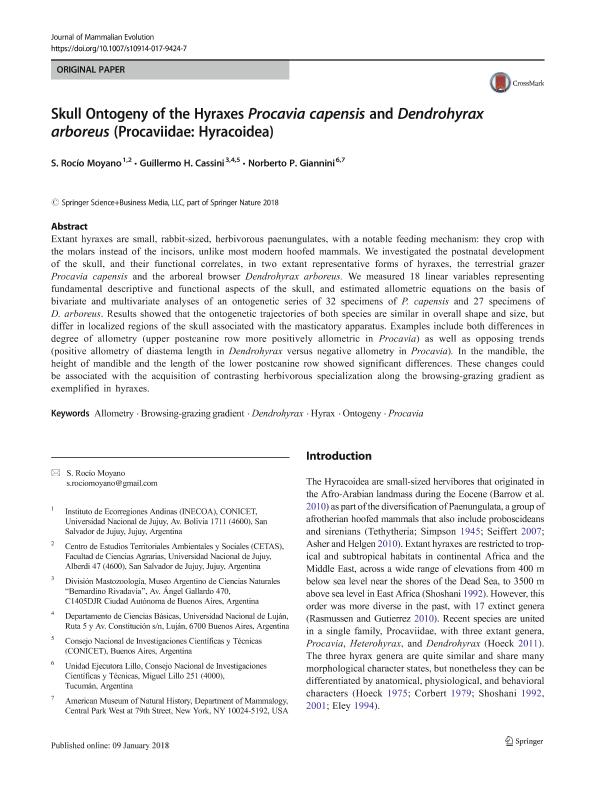Mostrar el registro sencillo del ítem
dc.contributor.author
Moyano, Silvana Rocio

dc.contributor.author
Cassini, Guillermo Hernán

dc.contributor.author
Giannini, Norberto Pedro

dc.date.available
2019-10-17T20:24:46Z
dc.date.issued
2018-01
dc.identifier.citation
Moyano, Silvana Rocio; Cassini, Guillermo Hernán; Giannini, Norberto Pedro; Skull ontogeny of the Hyraxes Procavia capensis and Dendrohyrax arboreus (Procaviidae: Hyracoidea); Springer; Journal of Mammalian Evolution; 26; 3; 1-2018; 317–331
dc.identifier.issn
1064-7554
dc.identifier.uri
http://hdl.handle.net/11336/86192
dc.description.abstract
Extant hyraxes are small, rabbit-sized, herbivorous paenungulates, with a notable feeding mechanism: they crop with the molars instead of the incisors, unlike most modern hoofed mammals. We investigated the postnatal development of the skull, and their functional correlates, in two extant representative forms of hyraxes, the terrestrial grazer Procavia capensis and the arboreal browser Dendrohyrax arboreus. We measured 18 linear variables representing fundamental descriptive and functional aspects of the skull, and estimated allometric equations on the basis of bivariate and multivariate analyses of an ontogenetic series of 32 specimens of P. capensis and 27 specimens of D. arboreus. Results showed that the ontogenetic trajectories of both species are similar in overall shape and size, but differ in localized regions of the skull associated with the masticatory apparatus. Examples include both differences in degree of allometry (upper postcanine row more positively allometric in Procavia) as well as opposing trends (positive allometry of diastema length in Dendrohyrax versus negative allometry in Procavia). In the mandible, the height of mandible and the length of the lower postcanine row showed significant differences. These changes could be associated with the acquisition of contrasting herbivorous specialization along the browsing-grazing gradient as exemplified in hyraxes.
dc.format
application/pdf
dc.language.iso
eng
dc.publisher
Springer

dc.rights
info:eu-repo/semantics/openAccess
dc.rights.uri
https://creativecommons.org/licenses/by-nc-sa/2.5/ar/
dc.subject
ALLOMETRY
dc.subject
BROWSING-GRAZING GRADIENT
dc.subject
DENDROHYRAX
dc.subject
HYRAX
dc.subject
ONTOGENY
dc.subject
PROCAVIA
dc.subject.classification
Zoología, Ornitología, Entomología, Etología

dc.subject.classification
Ciencias Biológicas

dc.subject.classification
CIENCIAS NATURALES Y EXACTAS

dc.title
Skull ontogeny of the Hyraxes Procavia capensis and Dendrohyrax arboreus (Procaviidae: Hyracoidea)
dc.type
info:eu-repo/semantics/article
dc.type
info:ar-repo/semantics/artículo
dc.type
info:eu-repo/semantics/publishedVersion
dc.date.updated
2019-10-16T19:13:27Z
dc.journal.volume
26
dc.journal.number
3
dc.journal.pagination
317–331
dc.journal.pais
Alemania

dc.journal.ciudad
Berlín
dc.description.fil
Fil: Moyano, Silvana Rocio. Universidad Nacional de Jujuy; Argentina. Universidad Nacional de Jujuy. Facultad de Ciencias Agrarias. Centro de Estudios Ambientales Territoriales y Sociales; Argentina
dc.description.fil
Fil: Cassini, Guillermo Hernán. Consejo Nacional de Investigaciones Científicas y Técnicas. Oficina de Coordinación Administrativa Parque Centenario. Museo Argentino de Ciencias Naturales "Bernardino Rivadavia". Estación Biológica de Usos Múltiples (Sede Corrientes); Argentina
dc.description.fil
Fil: Giannini, Norberto Pedro. Consejo Nacional de Investigaciones Científicas y Técnicas. Oficina de Coordinación Administrativa Parque Centenario. Museo Argentino de Ciencias Naturales “Bernardino Rivadavia”; Argentina
dc.journal.title
Journal of Mammalian Evolution

dc.relation.alternativeid
info:eu-repo/semantics/altIdentifier/doi/https://doi.org/10.1007/s10914-017-9424-7
dc.relation.alternativeid
info:eu-repo/semantics/altIdentifier/url/https://link.springer.com/article/10.1007%2Fs10914-017-9424-7
Archivos asociados
